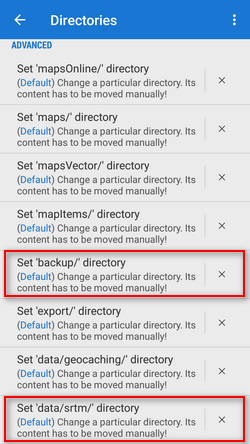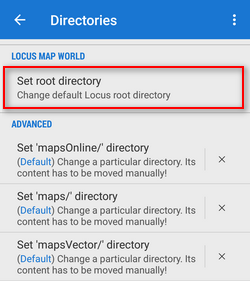Translated from English by gtranslate.io
Sidebar
This is an old revision of the document!
Table of Contents
Locus data on external SD card
Important!
Before Android 4.4.2., Locus Map was designed to work with SDcard as external storage space for all data related to the application - downloaded SQLite maps, point databases, SRTM data etc. After KitKat came on stage SD card reading/writing permissions were completely redefined:
- random reading of any place in a file stored on SD card was disabled
- random writing at any place in a file stored on SD card was disabled
Without these permissions any database is useless and that is why it is not possible to have your tracks, points, downloading directory of online maps, online maps cache and lots of other DTB-related files on the external SD card root directory.
For more information please see:
Locus Map installs itself in the internal memory of your device. During the installation a default directory structure “/Locus/..” is created in the internal memory too. This configuration, however, might be problematic for devices with little inner storage space. Nevertheless, there are methods how to use all or some of your data on an external drive and save your inner memory space:
Locus in internal and some data in external storage - RECOMMENDED
The best solution you can get is to have Locus installed in the inner storage and some of your data placed in the external SD card:
- raster maps - map tiles downloaded by Locus or from external sources
- vector maps - e.g. LoMaps or OpenAndroMaps
- backup files - created by the Backup manager
- SRTM data - elevation data from online or offline sources
Raster maps
All maps you are downloading by Locus from online sources or from Locus Store are stored by default in /Locus/Maps/ directory in the inner storage of your device. This, unfortunately, can not be changed. Nevertheless, all downloaded maps can be transferred to your external SD card (with any mobile file manager, e.g. ES Explorer) and linked to Locus via the Add external map command. The same procedure can be applied to all other raster maps obtained from other sources out of Locus.
Vector maps
LoMaps or other vector maps are stored by default in /Locus/mapsVector/ directory. You can use any directory on the external SD card for downloading and storing vector maps but you have to redefine the path to it in Locus settings:
- create a new folder for your vector maps on the external SD card, e.g. “mapsVectorExt”
- move contents (if there are any) of /Locus/mapsVector/ folder to the new folder “mapsVectorExt”
- define a new path to your vector maps in Locus settings > Miscellaneous > Default directories > Set 'mapsVector' directory

- restart Locus
Backup files and elevation (SRTM) data
These data have their folders in the internal storage basic structure /Locus/backup/, resp. /Locus/data/srtm/. You can change their location to the external SD card the same way as with vector maps and redefine their directories in Locus settings > Miscellaneous > Default directories > Set 'backup' directory (or Set 'data/srtm/' directory)

Locus and all its data on SD card
Every app on Android has its own special folder on the external SD card which is writable only for this app and as such can be used as the only storage space for the app. However, we do NOT recommend it, because:
- Locus Map on SD card is much slower than in the inner storage
- External SD cards get easily malfunctioned and you can lose all your maps/tracks/points data
- All content of this folder, including your purchased maps, recorded tracks or downloaded geocaches will be automatically deleted when you uninstall Locus.
- If you upgrade from Locus Map Free to Locus Map Pro, you can not use the same data (maps/tracks/points) as the two apps create their own individual directory structures.
Anyway, if you decide to use this option, follow these steps:
- Open Locus > Menu > Settings > Miscellaneous > Default directories > Set Root directory

- Select path which ends with “menion.android.locus/files” or “menion.android.locus.pro/files”

- Move whole “Locus” folder to the directory defined in previous step with a File browser
- Restart Locus
Advanced methods
Rooted devices
- In case that your device is rooted you can fix it by editing the system configuration
- Install application SDFix and perform the system changes
- Restart Locus. It can write on your external SD card as it could in Android 4.3.
Another option for rooted devices is to format your SD card in FAT32 system in your PC. That eliminates the file system rights. If you use a SD card larger than 64 GB you need a tool like H2format for Windows to format the SD card with FAT32. Be aware that this does not support files larger than 4 GB.
Beginning with Android 6, even rooted devices can not get random writing permission to the external SD card root directory.
TWRP
This method should be tried only if you are an experienced Android user. It is not tested on ALL devices so it might not work for everyone.
- Install ExtSD Fix 1.9 latest stable Version (v2.9b - 2016-06-09) by rufus.wilson
- Open “TWRP” app and go to the menu “Install” and select the “ExtSD_Fix_rw-signed-v1.9b.zip” Zip-File.
Important for TWRP
Only install with “TWRP” App over the Menu “Install“. You must open the menu „Install TWRP“ und select your device and the „Recovery Version to install“ and download it. Then download and install „twrp-3.0.2-2.klte.img“. Boot the Android Device with the TWRP Recovery-Mod. Now you have Write Access for all apps on your extSD Card image.
It works fine with Samsung Galaxy S5 SM-G900F (TouchWiz) with Stock ROM (without Provider Branding) Android 6.0.1 (Marshmallow, API 23)
More information in this XDA forum >>
Is this article useful for you? Please rate it: {(rater>id=1|name=faq_use_sdcard_on_kitkat|type=rate|headline=off)}

